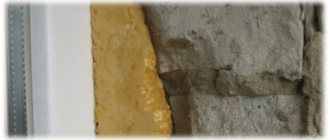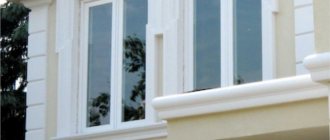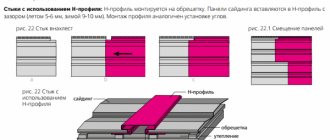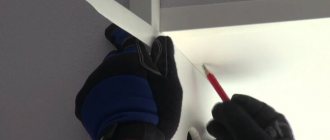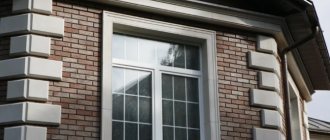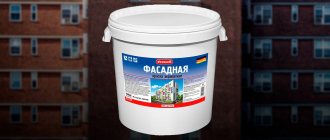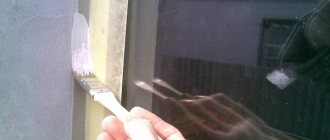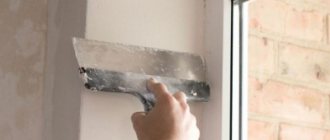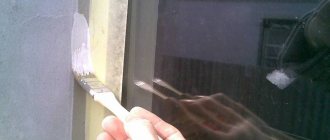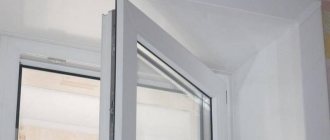Exterior works
To more reliably protect the room from heat loss, it is necessary to insulate the window slopes from the outside as well.
The best material for these purposes is penoplex. You will also need a special sealant for exterior use. In a private house, you can do the work yourself, but in a multi-story house it is better to use the services of professionals. The technological sequence of operations is as follows:
- Clean the surfaces of external slopes from dust, dirt, paint residues, finishing and building materials.
- Level with cement mortar and allow the layer to dry.
- Cut the insulation into pieces of the required size.
- Coat the sheets with glue and install them on the slopes. Additionally secure in several places with dowels.
- Mount the corners. Do not neglect this stage. As a result, you will receive not only insulated, but also smooth slopes.
- Treat the front surface of the penoplex with special glue and secure the reinforcing mesh.
- Level with putty.
- After drying, apply water-based paint or other finishing materials.
The issue of slope insulation should not be ignored. The microclimate in the house and the size of the electricity bills depend on how well and timely this is done. Moreover, the whole process can be carried out independently.
Exterior window decoration: photo examples and step-by-step instructions
To maintain a comfortable microclimate in the house, modern windows are needed. And the first thing you need to do after installing them is to properly finish the slopes. In this article we will look at options for finishing windows outside the house. What materials and technologies to use. In the text you will find step-by-step instructions and master classes on how to do it yourself, what problems may arise if the rules are not followed.
Exterior window decoration: photo examples and step-by-step instructions.
Finishing the windows from the outside is the last and necessary moment in the window installation procedure. At the final stage, it is necessary to hide the rough surface of the walls, fastenings, and polyurethane foam. You shouldn’t put off this important moment “for later.” Facing the slopes from the outside gives the window and entrance group visual appeal and completeness. It masks unsightly foam stripes and cracks formed during installation, and more importantly, it helps protect the structure on the street side from destruction. Preserves its original properties and ensures durability.
How to make external slopes for polystyrene windows step by step diagram
Step 1: Preparing the adhesive
Before proceeding with installation, you need to prepare a suitable adhesive solution in advance. According to experts, Ceresit adhesive brand st-85 is most suitable. The adhesive composition is mixed very thoroughly so that there are no lumps left in the mixture. Stir until the mixture thickens: the glue should not flow down the spatula. Don't forget to prime the area around the window where the slopes will be installed.
Step 2: Installation of slopes
After this, we rub glue into the wall - this method will ensure the highest quality adhesion between the surface of the walls and the foam. Next, having already made a foam blank, we apply glue to the products, and for convenience it is best to use a notched trowel. They begin gluing work from the bottom of the product, while also checking that the products are glued correctly. To do this, use a building level. It is advisable to properly glue the joints of our slope strips. Having finished pasting around the entire perimeter, you need to coat the existing seams with glue once again.
Don't forget to apply glue to the area where the window sill will be installed. After this, we proceed to the installation of the side slopes in contact with the window frame. When carrying out work, you should not skimp on glue; otherwise, voids may form between the frame and the slopes. Excess composition is carefully removed with a damp sponge. We coat all the joints between the material again - this completes the work on installing the slopes.
Step 3: Finishing the Material
While the adhesive dries, we finish the foam to give it a good appearance. In this case, we once again treat the slopes with an adhesive solution and install the fiberglass mesh
Don't forget the importance of covering the outer and inner corners with perforated corners. After the surface is completely dry, the foam is covered with facade paint in several layers
To prevent the composition from getting on the glass (which will be very difficult to clean), cover the perimeter of the glass unit with a wide piece of construction tape. But for the finishing (finishing) finishing, rely on your tastes, since modern manufacturers will be able to offer you a wide selection of products. So, you can purchase a color that will change the color of the slopes; acrylic paint with small particles will also work - this will create an unusual effect.
Why is it worth doing insulation?
First of all, it is worth noting that insulation is an essential part of a high-quality installation of a window system, which subsequently will not only last longer, but will be distinguished by high functionality. The main reasons requiring insulation:
- The window frame does not fit tightly to the surface of the slopes, leaving corresponding seams, which are often filled with polyurethane foam for sealing. This material shows excellent thermal insulation properties, but often reacts to moisture and temperature changes, undergoing destruction and loss of basic functions.
- Window frames without additional finishing are poorly protected from the influence of external factors. If insulation is not carried out, the joints will be susceptible to water ingress, which, under the influence of low temperatures, leads to the destruction of the fastenings and subsidence of the window.
- After the structure shrinks, free spaces form between the window frame and openings, which lead to freezing and cold air inside the room.
- Insulated windows are not characterized by the accumulation of condensation from the inside, leading to the formation of fungus or mold.
Insulating the slopes protects the window opening from freezing and condensation.
In addition to functionality, insulating the slopes of the windows will give the structure a stylish appearance that will harmoniously blend with the interior of the room.
External window trim with plastic
The use of sheet plastic allows finishing work to be carried out as quickly and accurately as possible. The panels have an aesthetic appearance, they are durable and practical.
They do not require additional finishing, since they are ideally combined with the material of the frames and form a harmonious and complete solution in tandem.
Advantages of PVC slopes:
- long service life;
- extensive color palette; low thermal conductivity;
- no condensation forms;
- resistance to moisture and mold formation.
Weaknesses of plastic:
- the need for replacement in case of damage - cannot be restored;
- low noise and heat insulating properties.
We insulate the inside
Having decided how to insulate the slopes, we move on to practice. Sometimes it happens that when a plastic window is installed, despite good treatment with foam, the glass gets wet and there is a strong blow from the slopes. This is often the result of careless installation, as a result of which the structure will have to be put in order yourself.
- Remove any remaining foam.
- Treat the surface with a primer with an antibacterial effect to prevent the appearance of mold in the future.
- We plaster the window area, achieving a flat surface onto which foam plastic can then be easily glued.
- We thoroughly clean the plastered areas, apply primer and begin laying insulation.
- In the case of polystyrene foam, the surface must be scratched with an emery sheet to reduce the smoothness. After which the material can be safely glued to the slopes. When cutting out the required pieces of foam, measure out slightly larger sizes, which can always be trimmed instead of gluing the missing pieces.
Before gluing the foam, it is recommended to scratch its surface
. Let the structure dry and putty the corner. After laying the foam, we proceed to the finishing coating, chosen to our own taste. This can be plasterboard covering or decorative plastering.
Having figured out in practice how to insulate the slopes of plastic windows inside, we move on to external work.
Materials used
The range of materials used to insulate slopes on your own is quite diverse. Each of them has its own advantages and differs in installation and operation features:
- Mineral wool (not to be confused with glass wool - this material is highly undesirable to use for interior work). The main advantages are excellent heat and sound insulation properties. Disadvantage: high moisture absorption. If you notice that the windows are “sweating”, then it is better to abandon this type of insulation, as over time this can lead to the formation of mold and fungi.
The easiest way to insulate using mineral wool
Styrofoam. The material is inexpensive and easy to work with, which is why it is popular in various types of work.
Penoplex. It has improved performance characteristics compared to polystyrene foam, but it is also more expensive.
Sandwich panels. Modern and most convenient type of material. Already includes thermal insulation and protective layers. It harmoniously complements plastic windows and usually fits into any room design. Cons: relatively expensive.
The choice of the preferred material is made based on climatic conditions, the general condition of the walls of the house, the material capabilities of the owner, and the skill level of workers.
Select the required thickness of insulation.
Material selection
The modern building materials market is distinguished by a wealth of choice. Despite the wide variety of products presented, the most popular are polystyrene foam, polystyrene foam and mineral wool. Simply covering existing cracks has little effect, since the polyurethane foam is subject to destruction over time, and the plaster cracks and crumbles. Insulating slopes only from the inside will not bring the desired results, since soon the cold will again make its way into your home. There is only one way out - using high-quality thermal insulation materials for installation on the outside of the building.
Most experts recommend insulating windows with polystyrene foam.
Why is this particular building material recommended, which is not cheap compared to others? It is important not to confuse expanded polystyrene with polystyrene foam, because they differ in a number of significant properties:
- water absorption. The value for polystyrene foam is 10 times less. What does this mean in practice? If you place two slabs in water for 30 days, one will absorb 0.4% of its volume, the other 4.0%. As you know, under the influence of moisture, materials are destroyed, their weight increases, which means the load on the fastening elements increases. A wet surface releases heat faster, so the value of the water absorption parameter should be as low as possible;
- thermal conductivity. This is the most important parameter that determines the effectiveness of using insulation. Expanded polystyrene has lower heat loss compared to polystyrene foam by 27–46%. In combination with low density and light weight, the thermal conductivity value of 0.028 W/(m.K) makes it an ideal insulation material;
- tensile strength. Everyone wants the money invested in slope insulation to fully justify itself, and for the finished structure to last as long as possible. That is why, of the two insulation materials, you should choose expanded polystyrene, which is 5–7 times more reliable. This applies to both tensile strength and compression. The service life of both insulation materials differs by 2–5 times.
Expanded polystyrene is completely environmentally friendly. Its use will not have a negative impact either on the person who lays the insulation or on the environment during operation, despite temperature changes and humidity. The advantages of expanded polystyrene over conventional polystyrene foam are obvious. As for mineral wool, it has a much lower cost, and it may seem that using such insulation is more profitable. In fact, high thermal insulation characteristics are characteristic only of mineral wool boards, the price of which is higher than expanded polystyrene.
Rules and safety precautions
When insulating external slopes, you should adhere to the following rules :
If insulation of windows on the second or higher floor is required, it is recommended to involve specialists in high-rise work, since there is a high probability of doing the insulation incorrectly due to limited mobility.
Also, working at height can cause physical injury or property damage, and in the worst case scenario, you can die if you fall from a window.- When working with insulation based on mineral wool, as well as when drilling walls, you need to wear protective equipment for the eyes, hands and respiratory tract, since the dust suspension can lead to negative effects on the body.
- During work, care should be taken not to damage the window frame, insulating layer or fastenings. You also need to make sure that the insulation layer does not extend beyond the window boundary too much, as this will shift the dew point or cause deformation of the PVC layer.
How to make window slopes from polystyrene foam - step-by-step diagram
Step 1: Preparing the surface for work
Before proceeding directly with installation, you need to clear the area under the slopes from dust and dirt, and also cover all the cracks with either cement or putty. The surface is primed for evenness, and while the composition dries, it will be time to prepare the parts.
Step 2: Installation of slopes
After cutting and preparing the slopes, we apply an adhesive mixture to their inner surface, after which we apply the material to the installation site. When pressing parts, it is worth using a building level for reliability in order to be able to check the evenness of the work. Despite the high quality of modern glue, for reliability you can secure the slopes with dowels by drilling several holes along the edges of the foam. By the way, experts do not recommend making holes for nails until the glue has dried. If you make the slightest mistake when carrying out work, this can lead to the set level of the foam moving. It is better to drill holes either in advance or two to three hours after finishing the work.
Step 3: Finishing the material
The surface of the material is puttied, all joints and cracks are properly sealed, providing good insulation and protection from drafts. The entire surface of the products is covered with starting putty, and a reinforced mesh is installed on top: carefully press it into the mixture with a spatula. To prevent the corners from collapsing during work, glue perforated corners to them. As soon as this layer has dried, the material is once again covered with finishing putty, after which the foam is painted or the slopes are plastered.
Finishing slopes with foam plastic - advantages over the usual classics
A slope is a product that allows you to close the openings between the facade of the house and the window. Their installation is carried out only after you have installed the windows themselves. The main purpose of the product is to protect the house from moisture penetration, protect against heat loss and eliminate strong drafts . Unfortunately, even if you contact specialists to replace old windows, it is not a fact that they will install slopes unless you ask them about it in advance.
Until recently, many people made slopes from a variety of building mixtures, plaster, and even paint and varnish compositions. True, such materials were completely unsuitable for this, since the plaster quickly crumbled, which caused the formation of cracks. Plastic materials, which can undergo changes under the influence of wind and heavy precipitation, are also not suitable for this.
Today, external window slopes are increasingly being made from foam plastic, since the product has the following advantages:
- long service life;
- ease of installation;
- high level of thermal insulation;
- beautiful aesthetic appearance;
- not susceptible to rust;
- does not lose its appearance.
Stages of the installation process and their characteristics
Having decided on the key characteristics and advantages of the insulation, it is necessary to follow the installation technology
It is important to know how to insulate windows with polystyrene foam in such a way as to create excellent conditions for tightness and long-term operation. To do this, it is worth doing the work step by step, giving each stage great importance:
cut out strips of polystyrene foam to the required length and width. As a rule, a sufficient size is 5–8 cm. The thickness of the insulation should be at least 5 cm, otherwise the effect will be barely noticeable; We clean the external window openings. Expanded polystyrene adheres well to brick, so it is advisable to clean the surface of foreign building materials, especially if they adhere weakly
It is important to fill existing cracks with cement mortar and treat areas where mold or mildew has formed. The façade can be further strengthened by using a deep penetration primer; install polystyrene foam slopes
Special glue or dowels can be used as a fixer. The combined use of fasteners ensures greater durability of the structure. It is important to know that for better drying of the glue, a temperature of at least +5 degrees is required - keep this in mind when planning insulation. When using polystyrene foam, it is recommended to play it safe and install both types of fasteners to significantly increase durability; We blow out the cracks that have arisen with polyurethane foam, after which has dried, you can begin to apply the plaster. The process is mandatory, since even a material that is relatively inert to the influence of the external environment is subject to aging under the influence of environmental factors. It is important to use a reinforcement mesh during the installation process - it will provide additional protection for the surface. Plaster will give the product greater strength and provide it with a long period of operation. After plastering, the surface is painted.
How to insulate window slopes with polystyrene foam in order to extend the period during which the material will remain airtight? It is important not to rush in the process of installing slopes - in order for the insulation to stick better, it is necessary to allow both the glue and the mounting foam to dry well. In general, we can say that having an understanding of how to insulate slopes with polystyrene foam, even a non-specialist can cope with the task
Do you have the skills to work with the necessary building materials? Can you carry out each stage of the work carefully and accurately? The procedure does not require the use of special equipment, so feel free to start insulating window slopes.
Finishing windows from the outside with plaster: step-by-step instructions for completing the work
External slopes should be plastered immediately after the polyurethane foam has hardened.
Important! It is necessary to completely exclude the possibility of environmental factors affecting its integrity.
Materials and tools for doing your own work
The speed and efficiency of work depends not only on the skill of the master, but also on the availability of all the necessary materials and tools. So prepare them ahead of time so you have them all on hand.
You will need:
- container for preparing plaster mixture;
- construction mixer or drill with a special attachment for mixing components;
- a set of spatulas of various widths. You will also need a corner option;
- Master OK;
- building level;
- square;
- wide brush with soft bristles;
- plaster grater;
- building mixture for facade work;
- putty for exterior use;
- decorative plaster;
- fiberglass reinforcing mesh;
- primer solution.
Insulation of slopes inside with foam plastic or penoplex
Sheets of foam plastic or penoplex are the most common types of materials for insulating slopes. Work using them is carried out after installation of the double-glazed window in the following sequence:
- Slopes and areas between the frame and the wall, filled with polyurethane foam, must be plastered with cement mortar.
- After drying, treat the surface with an antibacterial compound.
- Cut the insulation to the required size. It is better to cut a larger piece - the excess can be easily trimmed after installation.
- Sand the surface with sandpaper. Coat with special glue for foam plastic. If you use foam, don't apply a lot of adhesive coating. This type of insulation expands when heated - in hot summer times, a thick layer of adhesive may crack and the coating will lose its thermal insulation properties. Apply the prepared insulation to the slope, partially covering the window frame.
- After the insulation has been glued, we fix it with plastic umbrellas.
- The next step will be mesh reinforcement.
- Then, we place the perforated corner on the putty and align it directly to the level.
- Apply a decorative coating to the front part of the insulation in accordance with the repair concept. This can be drywall followed by painting, plastic panels, colored plaster.
Finishing windows outside the house using plaster
Plastering slopes from the outside is the most economical way to finish slopes. For exterior work, special compositions for facades with thermal insulation additives are recommended.
Note! The solution must completely cover the mounting foam and reach the frame. In this case, the thickness of the layer cannot exceed 2 cm. Therefore, this material is suitable for relatively flat slopes. The resulting coating is carefully sanded and painted.
The material is applied to the prepared surface in several layers, each of which must be allowed to dry thoroughly.
The advantages of this type of finishing include:
- fire resistance and strength of the material;
- low cost of plaster mixtures and necessary tools;
- the ability to perform work independently.
Disadvantages of finishing slopes with plaster:
- the process takes a long time - 3-4 days;
- the coating gets dirty quickly and cracks may form;
- this type of finish has low thermal insulation properties;
- performance of work is associated with the formation of large amounts of dust and dirt.
How to insulate plastic windows for the winter
The material is selected depending on the area that needs to be insulated.
| Insulation | Mode of application |
| Polyurethane foam | The voids between the window opening and the frame (installation seam) are filled around the entire perimeter |
| Mineral wool (for interior work) | Insulation of window sills and internal slopes with a mounting seam width of 30 mm or more |
| Foam plastic, polystyrene foam | Insulation of external and internal slopes with a mounting seam width of less than 30 mm |
| Dry building mixtures (plaster, putty for exterior work) | Insulation of slopes, protection of insulation from the influence of the external environment outside |
| Silicone sealant | Sealing gaps between plastic window elements |
| Construction tape | Glued on top of the sealant or instead of it |
| Energy saving film | Adheres to the inner surface of the glass unit |
| Rubber compressor | Replacing dry or damaged seals on the sash and frame |
To protect insulation from mechanical damage and as decorative coverings for slopes indoors, plastic panels and plasterboard are mainly used. The latter requires additional puttying and painting.
What are the features of polystyrene foam?
Advantages of polystyrene foam as a window slope Foam
plastic is a very common building material, which is increasingly used to insulate walls and even ceilings. Its main advantages are:
- affordability;
- environmental friendliness;
- resistance to the influence of external stimuli.
The table below shows the characteristics of the foam.
| Material Feature: | Index: |
| Water absorption in 30 days: | 4% |
| Water absorption per day: | 2% |
| Thermal conductivity: | 0.036-0.05 W/(m*S) |
| Tensile strength: | 0.07-0.2 MPa |
| Density: | 15-35 kg/m3 |
| Operating temperature range: | +50-70оС |
Slopes on windows made of polystyrene foam allow you not only to insulate your home, but also to make metal-plastic windows more attractive. Such material does not rust during operation and does not deform.
Important! According to the DIY installation technology, insulating slopes with polystyrene foam is very similar to installing drywall. But, if drywall is used exclusively as an internal finishing building material, then polystyrene foam can be safely used outside. You can make slopes from foam plastic inside the apartment, as well as slopes from foam plastic from the outside, as soon as the mounting foam, which is used to fill the voids after installing the window block, has dried.
When making window slopes with your own hands from foam plastic, please note that you need to fix the canvas along the entire perimeter of the window, also under the window sill. The main condition during finishing is to apply putty in more than one layer. Do not use an excessive amount of adhesive solution, because as a result of exposure to high temperatures, the foam will expand, after which cracks will appear. Due to such troubles, the structure will lose not only its thermal insulation properties, but also its attractiveness.
DIY polystyrene slopes (video)
Technology of work on the internal slope
To begin with, prepare the slopes yourself. They need to be cleared of debris and the cracks covered with cement mortar. Next, apply the primer with a brush to the entire surface. While the primed surface dries, we prepare the blanks (cut them to size).
Then, an adhesive solution is applied to the surface of the foam plastic with a notched trowel, and the workpiece is pressed against the slope. You can immediately pick up a building level, checking how level the installation is, because if the surface is uneven, this will significantly complicate the installation of windows. For a clearer installation, we recommend fixing the foam plastic to dowels at several points, then the plate will definitely not move away from the slope.
Next, all the foam plates are installed, with careful joining. If possible, you can additionally putty the joints to ensure that there are no gaps.
Now we apply the starting putty to the surface, attach the reinforced mesh, and apply the finishing layer of putty on top. So the internal slopes made of polystyrene foam are ready. What about the outside ones? Let's take a look now!
Properties and advantages of using polystyrene foam
Polystyrene foam is a universal material that is used in various cases. It has the following distinctive properties:
- Light weight. This makes it possible to carry out work without using additional forces, and also eliminates the need for auxiliary strengthening of surfaces.
- No harm to human health.
- Moisture resistance. The product does not absorb water and does not rot.
- Ease of preparation and installation.
- Low cost.
- Durability. The service life is calculated in tens of years.
- Additional insulation of slopes.
- Drill with mixer attachment.
- Construction knife.
- Level.
- Container for solution.
- Set of spatulas.
- Sandpaper.
- The slopes are covered with a layer of primer. This is necessary for good adhesion of the applied solution.
- The prepared putty mixture is applied in an even layer to the treated area.
- The first vertical element is coated. It is applied to the surface and pressed well. Next, a horizontal strip and the remaining vertical fragment are laid.
- If required, spacers are installed to help secure the glued sections.
- It takes 5-8 hours to dry completely, but it is better to leave the work for a day.
- Putty is applied to the surface. It is necessary to obtain a thin and uniform layer.
- Perforated modules are installed at the corners. They are completely covered with putty.
- Dried slopes are treated with sandpaper. Next, several layers of paint are applied.
Internal and external insulation of slopes
To ensure that the installed plastic window serves you for many years and meets all requirements, many experts strongly recommend insulating the slopes both indoors and outdoors.
After you have a new plastic window installed, you should not immediately start finishing the wall; you should initially take care of insulating the slopes and install thermal liners in the gap between the window and the wall.
When choosing a material for internal insulation of slopes, do not forget that the quality of insulation of the window opening depends on how tightly the heat insulator comes into contact with the surface.
When using the soft insulation materials discussed above, the gap between the window and the wall should be completely closed; hard materials should be laid end-to-end on top of the thermal liner.
Insulation of slopes with foam plastic
Foam insulation of window slopes is widespread due to the low price of the material (lower than other insulation materials) and dense composition.
But at the same time, in order to organize high-quality insulation of slopes using polystyrene foam, it is necessary to level the base on which installation will be carried out. It is better to carry out this work immediately after installing a new window. In this case, all slopes should be plastered with a special solution and create a flat plane at a certain angle.
Before gluing, sand the foam with sandpaper.
After the surface has been prepared for the installation of polystyrene foam, it should be treated with special antifungal compounds to create a protective barrier against mold growth between the surface and the foam plastic.
To ensure better adhesion of the material to the surface, the side of the foam on which the adhesive composition will be applied should be treated with sandpaper, giving the surface of the foam roughness.
It is customary to use the following materials for decorating polystyrene foam:
- decorative plaster;
- moisture-resistant drywall;
- decorative plastic panels.
The main parameter for choosing a material is the comparison of the product with the interior decor of the room. For more information about the stages of work, watch this video:
External insulation
As mentioned above, it is better to carry out insulation for slopes outside and inside. To level the insulated outer surface, a cement mortar or a special mixture is used; further work is not recommended until it has completely dried.
For exterior work, it is recommended to use penoplex (expanded polystyrene), since the density of this material is greater than that of foam plastic. Installation of penoplex is carried out using an adhesive solution, as well as the additional use of 2-5 dowels, depending on the size of the slope.
After the adhesive has hardened, another layer is applied to the surface, into which a reinforcing plaster plastic mesh is pressed. When the top layer of coating has hardened, you can begin decorating. For more information about insulating slopes, watch this video:
Summing up the written material, we can say with confidence that every owner can do the work of insulating slopes. There is no need to doubt the significance of this process, “the result will speak for itself,” and you can decorate the appearance of insulated surfaces with any of the above options.
Sometimes owners of windows made of metal-plastic profiles are faced with the situation that in winter cold air enters the room through the window opening (drafts, “drafts”). To decide how to insulate plastic windows, you need to find places and identify the reasons for the violation of thermal insulation.
Choosing decor for different types of openings
Before choosing a façade decor, you should clarify the type of window opening to be finished. He can be:
- straight;
- and a quarter.
In a straight opening outside the window, it is necessary to install slopes. Therefore, the L-shaped combination profile is ideal for installation.
An opening with a quarter does not need additional slopes, since the quarter itself replaces them. In this case, you can get by with plaster and use foam decor as platbands.
Thermal slopes are suitable for finishing both rectangular and arched openings. Moreover, the use of combined facade decor in an arched window allows you to avoid labor-intensive puttying of slopes.
Insulation with sandwich panels
One of the simplest and fastest ways to insulate window structures using sandwich panels.
In addition to the main material, to complete the work you will need a U-shaped profile, mineral wool, an F-shaped profile, and self-tapping screws.
Work process:
- secure the U-shaped profile around the perimeter of the window structure using self-tapping screws;
- prepare appropriately sized slopes from the specified building material;
- insert the panels into the mounted profile;
- the gap between the sandwich material and the wall can be sealed with mineral wool or another similar heat insulator;
- “transform” the outer side of the slopes with a finishing F-shaped profile.
How to determine where it's blowing from
Possible places for cold air to enter are:
- Connection of the window block to the wall panel along the entire perimeter (ceiling part, slopes, window sill);
- Seal between the sashes and the window frame;
- Fittings (worn or loose hinges, handle);
- Plastic bead securing the double-glazed window to the profile.
The main reasons for the formation of cracks in these places are:
- Violation of the rules for installing plastic windows;
- Warping of the window frame due to natural shrinkage of a new building or wooden house;
- The use of low-quality materials by the manufacturer in the manufacture of PVC profiles and by installers when installing windows in order to save money;
- Drying and cracking of the rubber seal;
- Wear of window fittings, leading to weakening of the clamping force;
- Failure to comply with the rules for operating windows (regular wet cleaning and treating the rubber seal with glycerin, cleaning and lubricating the clamping mechanism and hinges).
To determine the location of the blowing, it is enough to run the back of your hand along the listed elements. In a place where thermal insulation is damaged, a flow of cold air rushes into the room. For greater effectiveness, the palm can be wet.
If in doubt, you can use a lit match, lighter, or candle. They are carried out at a safe distance from the profile (2–3 cm) along the entire perimeter of the window. Deflection of the flame to the side indicates the presence of a draft from the gap.
You can determine where the air is blowing using a burning match.
The tightness of the seal can be checked using a sheet of writing paper. It is placed between the open sash and the frame. The sash is closed by turning the handle all the way. If the paper can be pulled out, it means that the seal does not fit tightly and there is a gap.
Detected places of cold penetration and cracks are marked on the drawing or with a pencil on the window profile
During insulation work, these areas should be given special attention.
It is recommended to call a specialist if:
- The warranty period has not expired;
- External insulation is required on high floors;
- The cause of the gap is a manufacturing defect;
- Replacement of worn elements of the clamping mechanism is required;
- The work must be completed efficiently and in a short time.
In other cases, it is more economical and expedient to do the insulation of plastic windows yourself.
Putty on foam plastic
One of the important stages of construction work on insulation is puttying on foam plastic. However, few people think about why to do this and how such work is done. If everything is more or less clear with puttying walls, then with polystyrene foam it’s not so much. There are a number of nuances associated with this.
In this article we will look at why you need to putty foam, how to choose the right putty, what tools and materials are needed for this. And to consolidate the result, we will look at step-by-step instructions on how to putty polystyrene foam.
What does foam putty give?
We are all accustomed to the fact that any action must be thoughtful, logical and have its own reason. For example, we sweep to keep the room clean. Why do you need to putty foam? Thanks to this, the quality of the finish can be improved. But that's not all. Here are some more reasons:
- Everyone knows how fragile polystyrene foam is. It is very easy to damage it if you move it carelessly or hit it. A crack or hole forms in place. If you putty it, this will increase its mechanical strength.
- This allows you to preserve the thermal insulation qualities of the foam. Despite the fact that moisture does not affect the material in any way, since it easily absorbs and releases it, low vapor permeability prevents the rapid removal of moisture from the foam structure. This is why the ability to retain heat deteriorates.
- Thanks to the putty, the anti-feather properties are increased. Everyone knows how resistant polystyrene foam is to fire. Even with a slight increase in temperature it begins to melt. A layer of putty will help eliminate the risk of fire or damage to the material.
- The foam will also be protected from ultraviolet rays and wind. They negatively affect the performance characteristics of the foam. In the sun it turns yellow and loses its original properties. Putty is an additional protective layer.
- Thanks to the putty, it is easy to apply the next finishing layer. This is like a foundation that is easier to work with in the future.
But in order for the putty to really fulfill all its tasks, it is important to choose a high-quality option. How to make the right choice?
Choosing putty for foam plastic
The peculiarity of polystyrene foam is that it melts when exposed to solvents. This means that the putty for it should not contain chemical components that will destroy the structure of the material. Otherwise, choosing the composition is not difficult. There are special mixtures for polystyrene foam.
There are several nuances that need to be taken into account when choosing putty for foam:
- Place of work. This can be façade putty or putty intended for interior work. The conditions outside the house are more aggressive, so the composition is different.
- Date of manufacture of the putty. In order to save money, some people buy discounted putty, the so-called promotional product. Typically, such events are abandoned when the shelf life of the material comes to an end. It is important to monitor this so as not to buy a composition that has lost its original characteristics.
- Storage conditions for putty. You should also consider where the products are stored. It is important that this is not a damp room that is not heated. And if this is a shed on the street, then temperature changes, dampness and sun had a negative impact on the raw materials.
- Presence of glue. Polystyrene foam cannot be called a material with high adhesion. Therefore, without an adhesive, the putty will not adhere well to the surface.
Why insulate slopes and options for materials used
The most common reason for insulating slopes is replacing outdated wooden windows with plastic ones, but this process does not always lead to the desired result, and dismantling work may not be carried out properly, which will lead to greater damage to the window opening.
A guaranteed increase in thermal insulation properties, regulated by manufacturing plants, is possible if certain requirements are met, one of which is the installation of insulated slopes.
The reason for the need for this insulation or insulation is that if this process is not performed, the direct barrier between a warm or cold space will be the window itself.
When installing a window, quite often there are invisible gaps through which warm air quickly leaves the room, and the new design has nothing to do with heat loss.
In order to reduce such heat losses and move the barrier (neutral) zone slightly towards the apartment (this process will eradicate the cause of mold on the slopes near the windows), the slopes are insulated.
You can see a visual view of the insulated “pie” in the diagram below.
Materials for slope insulation
Before insulating the slopes, it is worth deciding on the insulation option. Today there is a large selection of materials with which you can qualitatively insulate a slope, make it airtight and reliable. Such materials may include:
- mineral wool;
- glass wool;
- Styrofoam;
- expanded polystyrene;
- polyurethane foam;
- basalt wool;
- roll-type foil fiberglass;
- sandwich panels.
The choice of suitable material is made depending on what raw material the wall is made of and how the interior decoration of the rooms where the windows are installed is done.
The thickness of the insulation must correspond to the dimensions of the window
Insulating openings with soft materials is an effective method, but the parameters of the slopes and openings do not always allow resorting to this insulation option.
Since mineral, basalt and fiberglass wool are at least 5 cm thick, even when compressed they may not fit the dimensions.
In addition, these types of insulation require external cladding with a separate material, in particular, plastic panels or plasterboard.
Insulation of slopes can be done using foil fiberglass. This material may cause some difficulties during installation work, but it completely blocks the circulation of moisture and air between the room and the outside, while creating complete thermal insulation.
One of the most popular methods of insulating slopes are options using polystyrene foam and expanded polystyrene. These materials are dense and are perfectly placed using adhesive solutions on any surface.
Expanded polystyrene is well suited for insulating slopes
To give a decorative appearance to slopes insulated with penoplex or polystyrene foam, the surface should be plastered and painted.
Sandwich panels are also considered a modern, but expensive option for finishing and insulating slopes. They can be installed using liquid nails adhesive. The material is very reliable and does not require additional cladding.
External window trim with siding
Vinyl siding is ideal for finishing exterior windows. It is presented in the form of hollow plastic panels that are attached to each other using special locking systems. The material allows you to quickly create an aesthetic coating that has a certain level of thermal insulation and soundproofing.
The slats do not require additional finishing or complex maintenance. As additional insulation, it is recommended to fill the space between the siding and the wall with mineral wool or foam, and decorate the joints with decorative corners.
Advantages of vinyl siding:
- DIY installation is possible;
- slopes are easily cleaned of dust and dirt;
- no fungal growths appear on the plastic;
- many color options;
- will last a long time if handled carefully.
Disadvantages of finishing slopes with siding:
- color change may occur with intense exposure to ultraviolet radiation;
- insufficient shock resistance.
Preparatory process and cutting of finishing material
Before insulating slopes with polystyrene foam, you need to correctly cut the sheets. The size of the slope is closely related to the dimensions of the window, so you need to understand that they will have to be “planted” as deep as possible.
After cutting the parts, they are connected to each other with glue, which is applied to the seams. Then the glued product is left for a short time. Next, the prepared fragments are connected, pressing firmly, and left for 60 minutes to dry completely.
Fiberglass reinforcement
To achieve maximum strength, fiberglass reinforcement can be done. To do this, fiberglass is cut into strips, the width of which corresponds to the width of the slope. Fix the tapes with a stapler and then secure them with glue. When the glue dries, it is customary to putty the reinforcement, as shown in the photo above.
Preparing slopes - correct cutting of products
To make an external slope from foam plastic, it is necessary, first of all, to competently cut the products. The dimensions of the material will directly depend on the parameters of the windows. Here you should not forget that the slopes need to be seated to the maximum depth. Having cut out the layers of foam plastic, we begin to connect the already prepared parts together using glue: with a brush we apply the solution to the seams of the material and leave it there for about 10–15 minutes. Next, we connect the products, squeeze hard so that the glue takes hold and leave for one and a half to two hours until completely dry.
High-quality insulation of slopes of plastic windows is the key to maintaining heat in the apartment
Preservation of heat is one of the key conditions for comfortable living in an apartment during the cold period. Most often, an effective way to protect your home is to replace an old window with a modern metal-plastic one.
But choosing a high-quality design from a 5-6-chamber profile and a double-glazed window is not enough; the window itself, of course, will not let the cold into the apartment, but the places where it adjoins the opening, if they are not properly insulated, may well cause penetration cold air into the room. occurrence of dampness and mold.
Therefore, insulating the slopes of plastic windows is a task of paramount importance. The opening is insulated from the outside and inside of the window, using various types of materials
Decoration of the facade with slopes
Slopes made of expanded polystyrene help not only to effectively mask unwanted cracks and gaps, but also to perfectly insulate rooms. Polystyrene foam does not allow wind to pass through and reliably prevents drafts.
Polystyrene foam slopes from Azbuka Fasada LLC can be manufactured according to a standard design or according to an individual customer drawing. The variety of design solutions allows us to talk about foam slopes not only as constructive, but also as decorative elements.
Our consultants will help you calculate the exact cost of polystyrene foam slopes. Call.
